#fractal art computer art math art generative art
Text
But really the thing that gets me about the "AI art isn't REAL art" argument-
More than the fact that this is a complete subjective non-argument, more than the fact that attempts to MAKE it objective inevitably lead to...dark places-
Is the fact that, fine, even if we agree that AI generation isn't INHERENTLY art, that's not going to take away the fact that humans fucking love taking "non-artistic" things and MAKING art out of them.
Look at ASCII art - that's "just" typing characters. Fractal art is a modern iteration of a long, LONG tradition of coloring math to make art. People ascribe meaning to found items and call them art - to broad agreement - all the time. Hell, this website itself has a whole subculture of shitposting artistic presentation into anything from candy wrappers to dog pee, or finding the value in art someone dreamed up and dismissed as nonsense upon waking.
So, sure, by one of my two own personal definitions of Art (1. Something someone creates or presents to project an idea; 2. Something someone finds Meaning in; i.e., potentially anything), yeah, I agree that, say, a generic portrait generated with no real intent beyond "look good on a shelf", because a Midjourney credit cuts into profits less than actually hiring an artist, to fill out a cover for Nepo Baby Cash Grab YA Book Of The Week isn't really Art. But what of when someone gives it an abstract prompt for the sake of seeing what the math engine produces in trying to make sense of it? What of when they find a result and spend 5 hours running it through multiple models, creating meaning in the chaos with every step? What of when someone shitposts up a storm, prints it out, and builds on top of it in the physical world? What of when someone uses it as a meditation on what latent space "looks" and "feels" like? What of when the flaws of the medium are the point? What of when the point is found in the fact that the computer doesn't know how absurd any given prompt is and just creates it anyway?
What if someone with hallucinations decides to take photos and img2img them into a deliberately imperfect approximation of what they see?
What if someone takes photos of their childhood play spots and img2img's them into what they imagined?
What if someone just challenges themself to take this "unartistic" medium and run wild with it for a full 24 hours to create one piece and a full meaning they can ascribe to it?
What if someone makes a whole series of art about jailbreaking the walled gardens of corporate AI?
This isn't a theoretical thing someone COULD do but no one IS - none of this is uncommon in the hobbyist space, because again, human beings will make art out of anything. ANYTHING. It's just what people do!
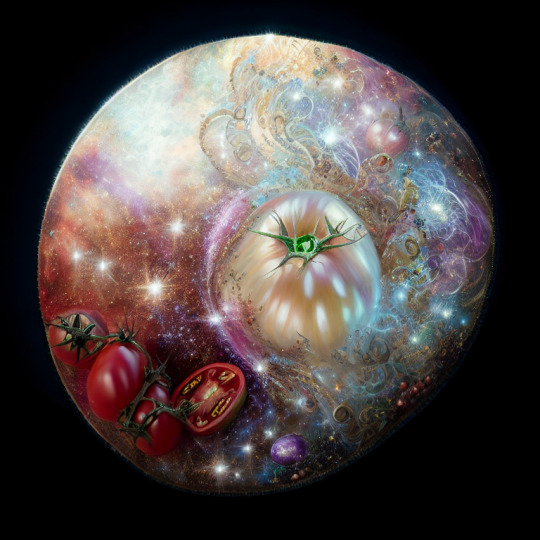
The Great Cosmic Tomato, created using img2img on a public domain photo of the planet Pluto from NASA's New Horizon's mission
Generated under the Code of Ethics of Are We Art Yet?
13 notes
·
View notes
Text
"Just pick up a pencil."
I honestly disagree with this sentiment.
Let's start with the collateral damage.
There is generative art out there that isn't made through GANs or other similar methods. Reddit's r/generative is home to this kind, made without either lifted training data or a prompt-based workflow. Just math, computer wizardry, and human ingenuity. You can make beautiful fractals, flowing shapes, etc., and you can take as many liberties as you want. Yet this unrelated art form happens to share the name "generative."
Then there's procedural effects in 3D digital art, animation, VFX, and CAD. I see that form of randomness as no worse than the natural imperfections that result from a pencil or paintbrush.
Even stabilization tools on apps like ProCreate have come under fire.
People hear about "Photoshop's plagiarism algorithms" and think the whole app uses them, or that Gaussian blur algorithms use content from Google Images.
I think a lot of the "pick up a pencil" crowd are missing the point and vilifying all computer-aided art forms as soulless, or making points tangential to the overall AI debate.
I can follow the logic behind a lot of arguments over the collection of training data for "true" AI art made with GAN and stable diffusion-based models, or the skill level of prompt engineering. (But I don't agree with banning or shaming it at all, or even with the idea that it's wrong, as enforcing the copyright of images from a Google Search would inadvertently ban many memes, and stable diffusion is way more complicated than a simple collage)
But mathematical or random models, liberties left to the computer, and digital art in general, are unfairly vilified in the process.
It's okay to pick up a pencil. But you can pick up a stylus, pick up your finger and put it on whatever control is in reach, etc., or pick up your technical intuition in one way or another.
And I also would love to see more ML-based AI that gives an artist even more liberties, and that discloses, for example, what it was trained on (perhaps consensual algorithms or mass libraries of stock photography).
Hypothetically, not all "true" AI has to be based on prompt engineering, or use it as the sole means of calling up images – and prompt engineering can also be used for finer details, etc. Perhaps as a way of generating the textures of 3D polygon animation.
But the goalposts keep moving.
This AI was trained on images in the public domain/that the company has permission to use!
Well, did the artists know at the time?
Well, this AI was trained on images expressly submitted to us!
But still, you're enabling non-artists to make fake art!
How?
Well, all you're doing is typing in a paragraph!
But this system has more areas to type in what you want, not just a single box!
But still, writing isn't making art!
Okay, this system more closely resembles a drawing program that turns your basic sketches or lasso fills into whatever you want them to be – the composition is yours!
But that's too easy!
Okay, this system just uses a really good ML algo to imitate brush strokes of a paintbrush!
Well....
"Why can't we use computers to simplify the boring stuff instead of simplifying the fun stuff?"
I've heard this so many times... implying that making art with a computer isn't fun, or that using a computer to automate or randomize anything is an insult to those who "took the time."
A few people speaking about AI music seem to also criticize things like random LFOs, random note generators, etc., that influence the sound design or composition of a production in a random way, though still ultimately on the terms of the producer. It's still a craft of love, and a great way to make cool R2D2 sounds or glitchy percussion.
Or speak of live musicians as the victims of AI music – something that as an electronic musician, I've heard about my hobby in general. That quantizing and pitch correction, or any kind of post-modification of any performance, is dishonest or disrespectful to those who "took the time" to learn to "properly" play. As if music were a sport, not an artform with many ways of practice. That gridding things in or arranging stock samples (a term that has two meanings: either arranging single notes or adding stock loops, or even bits of other songs) is dishonest. A lot of people don't even know that you can program in original melodies in electronic music, or skip samples entirely and use geometric or electronically-generated waveforms.
As if we don't take the time to develop our sounds and mix and match a variety of nonstandard, yet technical, areas, even if we leave some stuff to the computer and/or a stock loop library (or not... I tend not to use the latter).
As if people making any kind of procedural medium on a computer are only doing it because they're inartistic.
As if someone's personal opinion that 3D art with procedural FX, generative mathematical art, the music of Trovarsi, or anything with some randomization is soulless... makes it so.
As if they could do better just sitting down at the tools of the "talentless hacks'" trade.
As if anyone can sit down and make anything on r/generative, or even use Photoshop's Generative Fill, effectively on the first go.
One friend of mine thought electronic music was talentless and unoriginal, and that it was all "soulless and sterile and made from stolen loops"... I offered her 10 minutes of time with my laptop and a pair of headphones... she didn't want to try it out...
Speaking of that, when GarageBand was first announced to the general public, Steve Jobs mostly focused on the stock loops, even though you could make your own loops, record performances all the way through, or just grid things in... or use third party plugins.
I can see a similar trend happening with ML-based AI.
People will take the time to make it, and people will find it worth their time to consume it.
The opposite of "electronic" isn't "real". This is the force of thunder, thought, magnetism, chemistry, and emotion itself.
The opposite of "computer" (adj.) isn't "human." Humans designed computers.
And a lot of more "computery" art and music is very appealing to me. Am I a robot? No, but I'm of the species that designed them, and can tell you first-hand that creativity is very... complicated. Not that I don't think we should have it, but that it's ultimately in the eye of the beholder.
You didn't plan out each imperfection of your pencil line.
Nor each variation in harmonic overtone content or waveform each time you slap your bass.
Nor were you the first to draw a person, photograph the LA River, or tap out a clave rhythm.
Nor do comic book artists generally spend the same time on a single frame as a realist painter does on a whole painting... but that just lets them make more and create a whole new art form. And some comic book artists do slave away on each detail – or draw stick figures and still make effective comics. Or just take pictures for a photo comic. Or use stabilization. Or generative (mathematical) backgrounds.
Not too long ago, calculators were controversial in STEM classrooms. Now, many classes outright require them.
Not too long ago, spell check was lamented by English teachers. Now, many will outright encourage its use in typed essays, or have students do assignments on Canvas with it turned on.
The general attitude for using Wikipedia for research has evolved from "never use" to "use with skepticism and don't cite directly for school, but it's a great 'springboard' to find more info".
And typing has pretty much replaced cursive's role in high schools.
It's all how you look at it.
I will not be convinced that my computer is evil or unhealthy.
0 notes
Text
This is one of the few pieces of retro tech in my collection that I've owned since new. A TI-83 graphing calculator bought circa 1999 as a requirement for my high school maths class. The manual is bigger than the calculator itself which was pretty exciting for a young nerd.
These run off a Z80 and have a pretty decent version of Basic. I wrote some simple games and even back then heard rumours of people running Doom although no one ever had proof at my school. The internal battery must still have a charge because it has some of my programs and pixel art!
There's a ton of half working things on it, but the first one is a loader for the programs I considered my best. You could draw using the cursor keys or generate images using maths, so one of the programs just displays pictures. I was into Thief: The Dark Project and fractals, not much has changed there.
I first learned about Markov chain text generators around this time too and the idea of computer generated text blew my mind. I remember writing this super rudinentary sentence generator during a maths class... and suddenly I understand why I'm so bad at trig and calculus.

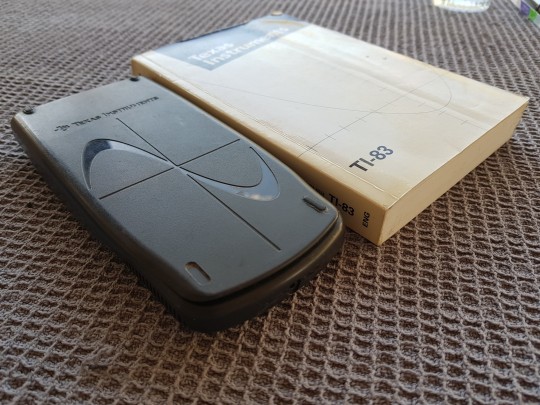


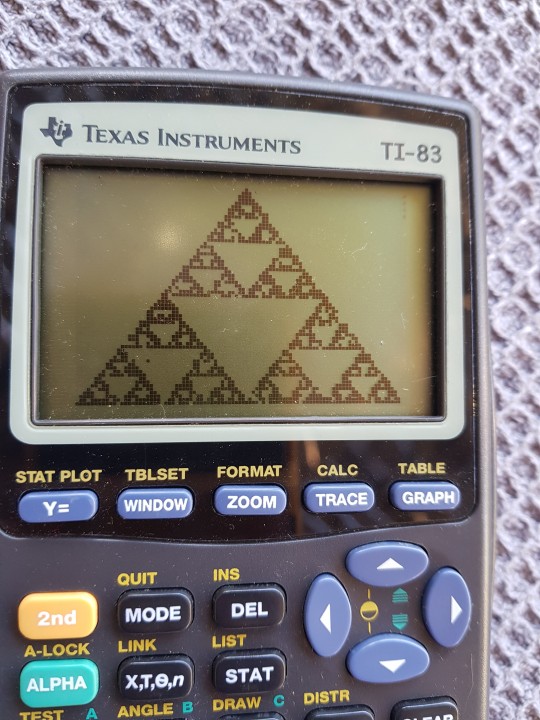
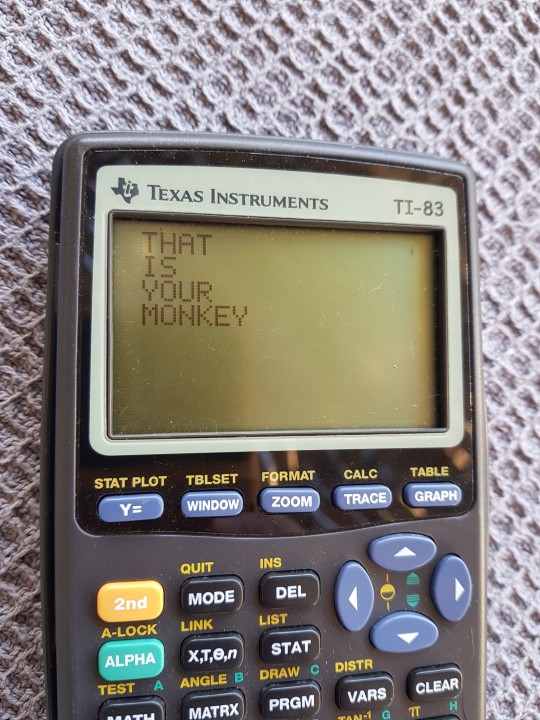

0 notes
Text
Cellular automata - 1D Binary. silent 4k
Cellular automata - 1D Totalistic. silent 4k
Cellular automata - Cyclic CA. silent 4k
Cellular automata - General Binary. silent 4k
Cellular automata - Generations . silent 4k
Cellular automata - Larger than Life. silent 4k
Cellular automata - Life. silent 4k
Cellular automata - Conway's Life. silent 4k
Cellular automata - Life - Day&Night. silent 4k
Cellular automata - Margolus. silent 4k
Conway's life, game of life, classical cellular automaton, classical game of life, patterns of a classical cellular automaton, dynamics of a classical cellular automaton, evolution of a classical cellular automaton, classical model, classical life, classical game, cellular dynamics, cell dynamics, cell population, virtual cells, Self-organization patterns, Dynamic patterns, Emergent patterns, Emergent patterns, Stable structures, Self-organization dynamics, Self-replicating structures,
Sierpinski triangle, fractal self-organization, fractal models, dynamic fractals, fractal dynamics, fractality, fractal modeling, Fractal, fractal self-similarity, fractal generation, fractal expansion, fractal propagation, fractal growth, fractal reproduction
logic gates, logical elements, basic algorithms, computing system, Turing completeness, Turing complete rule, Cellular automata, Discrete Simulation, Math modeling, Computer modelling, computer models, Discrete Models, Models of self-organization, abstract video, Science video art, Cellularum automata, Discrete Simulatio, Math modeling, Computer modeling, computatrum exempla, Exempla discreta, Exempla auto-organization, abstractum video, Scientia video art
Psychedelic, psychonautics, psychedelic patterns, psychedelic video, psychedelic animation, video psychedelic, movie psychedelic, psychedelic animation, psychedelic colors, psychomodeling, psychedelic modeling, cellular automata psychedelic, self-organizing psychedelic, self-organized criticality, cellular psychedelic, psychedelic models, visual psychedelic, line patterns, linear-angular patterns,
Generative art, modeling art, cellular automaton art, model art, scientific creativity, interactive painting, evolving art, dynamic art, generative art, computer art, digital art, digital paintings, dynamic paintings, mathematical art, mathematical art, vanishing paintings, vanishing art, discrete creativity, discrete art, discrete art, art models, art modeling, art mathematics, athematic art, art-and-mat, artimatics
Virtual creatures, virtual creatures, virtual creatures, virtual insects, artificial creatures, artificial creatures, imitation of the living, imitation of life, imitation of living beings, imitation of mobility, imitation of movement, imitation of birth, imitation of death, virtual birth, virtual death
Sedimentation, conglomerate formation, aggregation, sedimentation, crystallization, modeling, spherization
Self-organization patterns, Dynamic patterns, Emergent patterns, Emergent patterns, Stable structures, Self-organization dynamics, Self-replicating structures, Self-replicating patterns, Emergent sets, Stable dynamics, Dynamic structures, Abstraction, Emergence, Virtual evolution, Virtual population, Phase transition, Self-organization, CA , Cellular automata, Discrete modeling, Mathematical modeling, Computer modeling, Computer models, Discrete models, Self-organization models, Abstract video, Science video art, Sci art, Science art
Science cartoons, Science cartoons, Self-organized symmetry, Science art cartoons, Cartoon cartoons, Cartoons for geeks, Cartoons for insiders, Cartoons for scientists, Intellectual cartoons, Abstract cartoons, abstract cartoons, scientific cartoons, mathematical cartoons, mathematical animation, computer cartoons, computer animation,
discrete animation, algorithmic animation, algorithmic cartoons, cell animation, cartoons about cells, cell cartoons, cartoon cell atoms, moving patterns, cartoon patterns, cartoon patterns, cartoon evolution, cartoon dynamics, animation, animated video, computer animation, abstract animation, discrete a nimation , self-organization animation, simulation animation, model visualization, self-organization visualization, self-organization dynamics visualization, cellular automata visualization, cellular animation,
dynamic mosaic, dynamic population, population dynamics, symmetrical growth, fractal-like growth, flickering mosaic, flickering pattern, dynamic pattern, symmetrical pattern,
Паттерни самоорганізації, Динамічні патерни, Емерджентні патерни, Емерджентні візерунки, Стійкі структури, Динаміка самоорганізації, Саморепліковані структури, Саморепліковані патерни, Емерджентні множини, Стійка динаміка, Динамічні структури, Абстракція, овий перехід, Самоорганізація, CA , Клітинні автомати, Дискретне моделювання, Математичне моделювання, Комп'ютерне моделювання, Комп'ютерні моделі, Дискретні моделі, Моделі самоорганізації, Абстрактне відео, Науковий відеоарт, Sci art, Science art
Наукові мультики, Наукова мультиплікація, Самоорганізована симетрія, Science art мультфільми, Мультики-пультики, Мультфільми для гіків, Мультфільми для посвячених, Мультфільми для вчених, Інтелектуальні мультфільми, абстрактні мультфільми, абстрактні мультфільми чеська мультиплікація, комп'ютерні мультфільми, комп'ютерна мультиплікація,
дискретна мультиплікація, алгоритмічна мультиплікація, алгоритмічні мультфільми, клітинна мультиплікація, мультики про клітини, клітинні мультики, мультяшні клітинні атомати, рухомі патерни, мультиплікаційні патерни, мультиплікаційна еволюція, мультиплікаційна ктна анімація, дискретна анімація , анімація самоорганізації, анімація моделювання, візуалізація моделі, візуалізація самоорганізації, візуалізація динаміки самоорганізації, візуалізація клітинних автоматів, клітинна анімація,
динамічна мозаїка, динамічна популяція, динаміка популяції, симетричне зростання, фракталоподібне зростання, мерехтлива мозаїка, мерехтливий патерн, динамічний візерунок, симетричний візерунок,
Wzorce samoorganizacji, Wzorce dynamiczne, Wzorce wyłaniające się, Wzorce wyłaniające się, Struktury stabilne, Dynamika samoorganizacji, Struktury samoreplikujące się, Wzorce samoreplikujące się, Wyłaniające się zbiory, Stabilna dynamika, Struktury dynamiczne, Abstrakcja, Wyłanianie się, Wirtualna ewolucja, Wirtualna populacja , Przejście fazowe, Samoorganizacja, CA , Automaty komórkowe, Modelowanie dyskretne, Modelowanie matematyczne, Modelowanie komputerowe, Modele komputerowe, Modele dyskretne, Modele samoorganizacyjne, Abstrakcyjne wideo, Nauka wideo-art, Sztuka naukowa, Sztuka naukowa
Bajki naukowe, Komiksy naukowe, Samoorganizująca się symetria, Komiksy naukowe, Kreskówki Bullet, Kreskówki dla maniaków, Kreskówki dla wtajemniczonych, Kreskówki dla naukowców, Kreskówki intelektualne, Kreskówki abstrakcyjne, bajki abstrakcyjne, bajki naukowe, bajki matematyczne, bajki matematyczne, bajki komputerowe , animacja komputerowa,
animacja dyskretna, animacja algorytmiczna, animacja algorytmiczna, animacja komórkowa, animacja o komórkach, animacja komórkowa, rysunkowe atomy komórek, ruchome wzory, rysunkowe wzory, rysunkowe wzory, ewolucja rysunkowa, dynamika rysunkowa, animacja, wideo animowane, animacja komputerowa, animacja abstrakcyjna, dyskretna animacja, animacja samoorganizacji, animacja symulacyjna, wizualizacja modelu, wizualizacja samoorganizacji, wizualizacja dynamiki samoorganizacji, wizualizacja automatów komórkowych, animacja komórkowa,
dynamiczna mozaika, dynamiczna populacja, dynamika populacji, symetryczny wzrost, fraktalny wzrost, migocząca mozaika, migoczący wzór, dynamiczny wzór, symetryczny wzór,
Pattern di auto-organizzazione, Pattern dinamici, Pattern emergenti, Pattern emergenti, Strutture stabili, Dinamiche di auto-organizzazione, Strutture autoreplicanti, Pattern autoreplicanti, Insiemi emergenti, Dinamiche stabili, Strutture dinamiche, Astrazione, Emergenza, Evoluzione virtuale, Popolazione virtuale , Transizione di fase, Auto-organizzazione, CA , Automi cellulari, Modellazione discreta, Modellazione matematica, Modellazione al computer, Modelli computerizzati, Modelli discreti, Modelli di auto-organizzazione, Video astratto, Video arte scientifica, Sci arte, Arte scientifica
Cartoni animati scientifici, Cartoni animati scientifici, Simmetria auto-organizzata, Cartoni artistici scientifici, Cartoni proiettili, Cartoni animati per smanettoni, Cartoni animati per addetti ai lavori, Cartoni animati per scienziati, Cartoni intellettuali, Cartoni astratti, Cartoni astratti, Cartoni scientifici, Cartoni matematica, Cartoni matematica, Cartoni computer , animazione al computer,
animazione discreta, animazione algoritmica, cartoni algoritmici, animazione cellulare, cartoni animati sulle cellule, cartoni animati delle cellule, atomi delle cellule dei cartoni animati, modelli in movimento, modelli di cartoni animati, modelli di cartoni animati, evoluzione dei cartoni animati, dinamica dei cartoni animati, animazione, video animato, animazione al computer, animazione astratta, discreto un'animazione, animazione di auto-organizzazione, animazione di simulazione, visualizzazione di modelli, visualizzazione di auto-organizzazione, visualizzazione di dinamiche di auto-organizzazione, visualizzazione di automi cellulari, animazione cellulare,
mosaico dinamico, popolazione dinamica, dinamica della popolazione, crescita simmetrica, crescita simile a un frattale, mosaico tremolante, motivo tremolante, motivo dinamico, motivo simmetrico,
#animación discreta#animación algorítmica#dibujos algorítmicos#animación celular#dibujos animados sobre células#dibujos animados de células#átomos de células de dibujos animados#patrones en movimiento#patrones de dibujos animados#evolución de dibujos animados#dinámica de dibujos animados#animación#video animado#animación por computadora#animación abstracta#discreto animación#animación de autoorganización#animación de simulación#visualización de modelos#visualización de autoorganización#visualización de dinámicas de autoorganización#visualización de autómatas celulares#треугольник Серпинского#фрактальная самоорганизация#фрактальные модели#динамические фракталы#фрактальная динамика#фрактальность#моделирование фракталов#Фрактал
1 note
·
View note
Photo
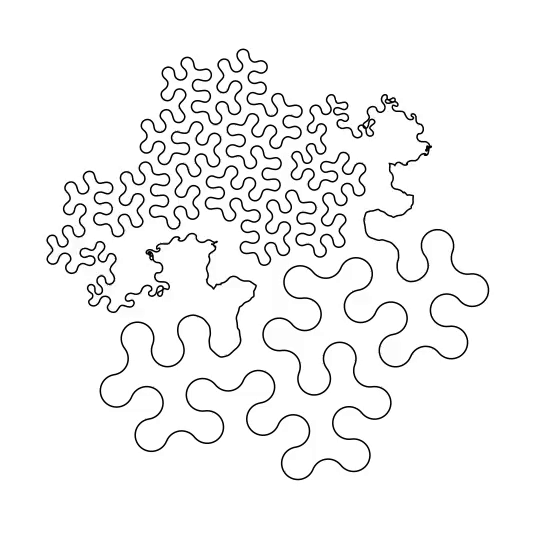
Rewrite 1.
638 notes
·
View notes
Photo
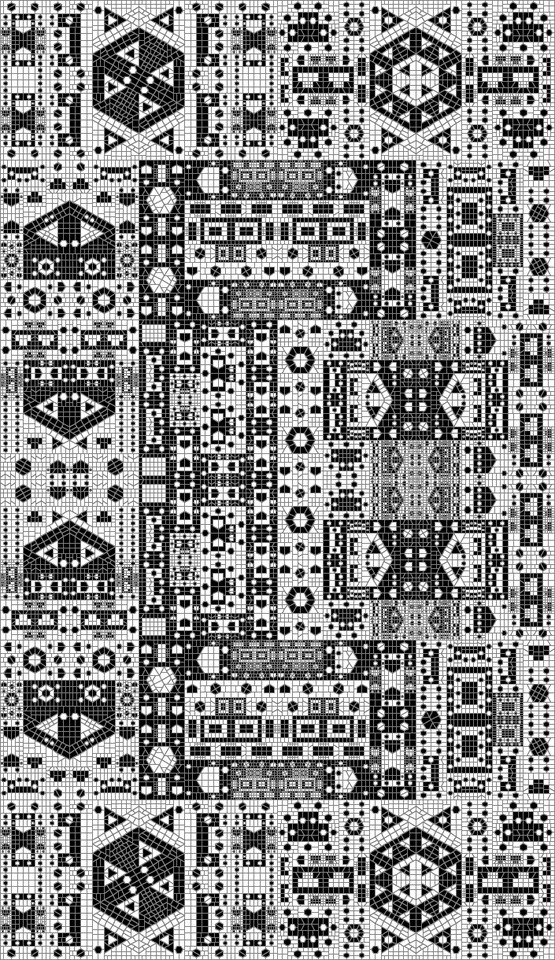
593 notes
·
View notes
Text
Masks, Cases and T-Shirts, Oh My! Nearly 5000 New Items On RedBubble! #Computer #Generated #Art #CGI produced on my #Linux #Cluster, aka supercomputer. TAPESTRIES JIGSAWS PILLOWS #EdTech #MathChat #SciChat #science #hpc #fractal
#fractals #povray #math
#edtech#mathchat#science#math#maths#stem#stemeducation#scichat#fractal#fractals#CompSci#c#cgiart#cgi#computer#generated#art#hoc#linux#cluster#prints#phone#cases#tapestry
0 notes
Photo
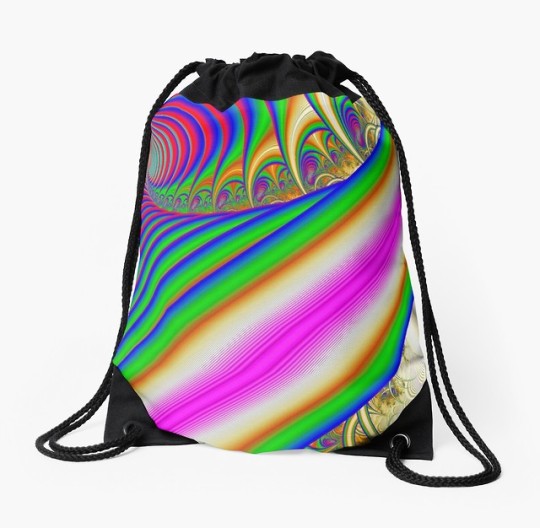
(via 'Victoria' Drawstring Bag by Squirrox)
0 notes
Text
Sonia Fenelon Explaining - The Great World of Fractal Arts.
Do you aspire to implement modern methods to incorporate S.T.E.A.M. into your Okay-12 Arts curriculum? Fractals are an interesting option to rejoice the arts, sciences, and mathematics. Moreover, fractals are nature’s D.N.A. and examples may be seen throughout us, from the microscopic patterns on a snowflake to the vast geographies of a shoreline.

Benoit Mandelbrot was the first scientist to graph a fractal set utilizing IBM computer systems to calculate complex mathematical equations. Mandelbrot’s exploration with new expertise connects Sonia Fenelon's personal ardour to utilize the most recent know-how to create her own artwork and improve Graphic Arts curriculum.
Moving to the Computer
Once college students embrace the fantastic world of fractals, they start designing their fractal mandala artwork on the pc. Utilizing a wide range of fractal generator applications, college students create and save high-resolution fractal photographs that will likely be utilized of their ultimate mandala designs.
The shapes that unfold at every magnification stage are primarily based on computations that may take months to complete on a typical desktop pc. With supercomputers like the Blue Gene, that point is condensed to a matter of hours.
Reflections
Creating artwork with fractals promotes many facets of cross-curriculum studying. With the excitement surrounding S.T.E.A.M. initiatives and the potential for collaboration with the science and math department, incorporating fractals into your art curriculum may also enable you to uncover a complete new world of studying. Fractals in art are an attractive way for art, science, and math.
3 notes
·
View notes
Text
Fractal Sketches
I am a physician by education. Also I'm an artist,creating unique fractal compositions based on mathematical formulas directions.
These are my favorite fractal pieces that I have created. When creating fractal art, I enjoy the discovery of beauty in math. Raw beauty that relates to the world we live in, in a digital format. These pieces are reflections of our world and universe.
Fractal Art is generated with algorithms based on mathematical computations which are then rendered to visual outputs on still and dynamic video form.
Developed in the 1980s, fractal Art is essentially mathematical beauty in abstract art form. The unlimited potential of outcomes in fractal Art is truly astounding.
These pieces make great computer, phone or t shirt print backgrounds.
My collection consists of more than hundreds of pieces. Please enjoy :) https://opensea.io/collection/fractalsketches
1 note
·
View note
Text
Recently we have been reorganizing our LThMath Book Club. The whole idea behind it is to read and discuss books with other people. We are happy that the Goodreads Club is steadily growing. We also have a Facebook Group with the same idea as the Goodreads one. Hope you all enjoy the idea. Due to this change, we cannot do just a Goodreads poll for the bi-monthly book. Therefor, we decided to do a survey (created using Google forms). In this way more people can vote for the book. If you want to vote, you need to do it HERE.
“Things to Make and Do in the Fourth Dimension: A Mathematician’s Journey Through Narcissistic Numbers, Optimal Dating Algorithms, at Least Two Kinds of Infinity, and More” by Matt Parker*
In the absorbing and exhilarating Things to Make and Do in the Fourth Dimension, Parker sets out to convince his readers to revisit the very math that put them off the subject as fourteen-year-olds. Starting with the foundations of math familiar from school (numbers, geometry, and algebra), he takes us on a grand tour, from four dimensional shapes, knot theory, the mysteries of prime numbers, optimization algorithms, and the math behind barcodes and iPhone screens to the different kinds of infinity ― and slightly beyond. Both playful and sophisticated, Things to Make and Do in the Fourth Dimension is filled with captivating games and puzzles, a buffet of optional hands-on activities that entice us to take pleasure in mathematics at all levels. Parker invites us to relearn much of what baffled us in school and, this time, to be utterly enthralled by it.
“The Music of the Primes: Why an unsolved problem in mathematics matters” by Marcus du Sautoy*
Prime numbers are the very atoms of arithmetic. They also embody one of the most tantalising enigmas in the pursuit of human knowledge. How can one predict when the next prime number will occur? Is there a formula which could generate primes? These apparently simple questions have confounded mathematicians ever since the Ancient Greeks.
In this breathtaking book, mathematician Marcus du Sautoy tells the story of the eccentric and brilliant men who have struggled to solve one of the biggest mysteries in science. It is a story of strange journeys, last-minute escapes from death and the unquenchable thirst for knowledge. Above all, it is a moving and awe-inspiring evocation of the mathematician’s world and the beauties and mysteries it contains.
“A Brief History of Infinity” by Brian Clegg*
Infinity is a concept that fascinates everyone from a seven-year-old child to a maths professor. An exploration of the most mind-boggling feature of maths and physics, this work examines amazing paradoxes and looks at many features of this fascinating concept.
“Proofiness: The Dark Arts of Mathematical Deception” by Charles Seife*
“Proofiness,” as Charles Seife explains in this eye-opening book, is the art of using pure mathematics for impure ends, and he reminds readers that bad mathematics has a dark side. It is used to bring down beloved government officials and to appoint undeserving ones (both Democratic and Republican), to convict the innocent and acquit the guilty, to ruin our economy, and to fix the outcomes of future elections. This penetrating look at the intersection of math and society will appeal to readers of Freakonomics and the books of Malcolm Gladwell.
“The Proof Is in the Pudding: The Changing Nature of Mathematical Proof” by Steven G. Krantz*
This text explores the many transformations that the mathematical proof has undergone from its inception to its versatile, present-day use, considering the advent of high-speed computing machines. Though there are many truths to be discovered in this book, by the end it is clear that there is no formalized approach or standard method of discovery to date. Most of the proofs are discussed in detail with figures and equations accompanying them, allowing both the professional mathematician and those less familiar with mathematics to derive the same joy from reading this book.
“How Not to Be Wrong: The Power of Mathematical Thinking” byJordan Ellenberg*
How Not to Be Wrong presents the surprising revelations behind some interesting questions, using the mathematician’s method of analyzing life and exposing the hard-won insights of the academic community to the layman — minus the jargon. Ellenberg chases mathematical threads through a vast range of time and space, from the everyday to the cosmic, encountering, among other things, baseball, Reaganomics, daring lottery schemes, Voltaire, the replicability crisis in psychology, Italian Renaissance painting, artificial languages, the development of non-Euclidean geometry, the coming obesity apocalypse, Antonin Scalia’s views on crime and punishment, the psychology of slime molds, what Facebook can and can’t figure out about you, and the existence of God.
Ellenberg pulls from history as well as from the latest theoretical developments to provide those not trained in math with the knowledge they need. Math, as Ellenberg says, is “an atomic-powered prosthesis that you attach to your common sense, vastly multiplying its reach and strength.” With the tools of mathematics in hand, you can understand the world in a deeper, more meaningful way. How Not to Be Wrong will show you how.
“Gödel, Escher, Bach: An Eternal Golden Braid” by Douglas R. Hofstadter*
Douglas Hofstadter’s book is concerned directly with the nature of “maps” or links between formal systems. However, according to Hofstadter, the formal system that underlies all mental activity transcends the system that supports it. If life can grow out of the formal chemical substrate of the cell, if consciousness can emerge out of a formal system of firing neurons, then so too will computers attain human intelligence. Gödel, Escher, Bach is a wonderful exploration of fascinating ideas at the heart of cognitive science: meaning, reduction, recursion, and much more.
“How to Cut a Cake: And Other Mathematical Conundrums” by Ian Stewart*
Welcome back to Ian Stewart’s magical world of mathematics! Here are twenty more curious puzzles and fantastical mathematical stories from one of the world’s most popular and accessible writers on mathematics. This is a strange world of never-ending chess games, empires on the moon, furious fireflies, and, of course, disputes over how best to cut a cake. Each chapter–with titles such as, “How to Play Poker By Post” and “Repealing the Law of Averages”–presents a fascinating mathematical puzzle that is challenging, fun, and introduces the reader to a significant mathematical problem in an engaging and witty way. Illustrated with clever and quirky cartoons, each tale will delight those who love puzzles and mathematical conundrums.
“The Mathematical Tourist: New & Updated Snapshots of Modern Mathematics” by Ivars Peterson*
In the first edition of The Mathematical Tourist, renowned science journalist Ivars Peterson took readers on an unforgettable tour through the sometimes bizarre, but always fascinating, landscape of modern mathematics. Now the journey continues in a new, updated edition that includes all the latest information on mathematical proofs, fractals, prime numbers, chaos and much more. Blazing a trail through rows of austere symbols and dense lines of formulae, Peterson explores the central ideas behind the work of professional mathematicians– how and where their pieces of the mathematical puzzle fit in, the sources of their ideas, their fountains of inspiration, and the images that carry them from one discovery to another.
We hope this helped you decide what book you would like to read in August – September with us. Hope you liked this post. Have a great day. You can find us on Facebook, Tumblr, Twitter and Instagram. We will try to post there as often as possible.
Lots of love and don’t forget that maths is everywhere! Enjoy!
*This post contains affiliate links and I will be compensated if you make a purchase after clicking on my links.
February – March Book Choice Recently we have been reorganizing our LThMath Book Club. The whole idea behind it is to read and discuss books with other people.
20 notes
·
View notes
Text
Art and science come together to examine the power and perversions of perfection
by Julie Shiels

Patricia Piccinini, Graham, 2016 Installation view, Nicole Cleary
Review: Perfection, Science Gallery Melbourne.
It would be easy to assume that art and science occupy separate worlds. Art invites us to encounter “things as they are perceived and not as they are known” and relies on subjective experience to confirm value. Science strives to establish knowledge as fact through testing and peer review. Yet sitting at the core of both disciplines is the desire to employ curiosity, creativity, innovation and discovery to examine the world we live in. These intellectual frameworks create bridges between the two disciplines.
The intersection between art and science is the focus of Perfection, the latest pop-up show for the Science Gallery Melbourne. Part exhibition, part experiment it asks: “What does it mean to be perfect?”
Curated by a panel that includes a particle physicist, a computer scientist, a plastic surgeon and a musicologist, Perfection offers a set of reflections, calculations and speculations that engage with ideas about the perfect body, mathematical precision, quantum physics and a post-human world. We are invited to consider the current state of things and to contemplate what might constitute an ideal future.

XORXOR, Perfect O, installation view. Image courtesy of the artists
The slippages between art and science, and experiment and exhibition, are an active component of Perfection. Questions that straddle technology and art history are explored by XORXOR’s question: “Is it possible to draw a perfect circle?”

Marcus Volz, Lorenz Attractor 201, Digital animation. Image courtesy the artist
Marcus Volz’s digital animations, Lorenz Attractor and Natalina Cafra, employ complex 3D sculptural forms to visualise mathematical equations relating to atmospheric weather patterns and fractal diversity in molluscs. Reminiscent of late modernism and the idea of a perfect closed self-referencing system, these drawings ask whether art can be maths and maths can be art.
The lab-like conditions of Andy Gracie’s Fish, Plant, Rack v.2 speculate on a future post-human condition where the world goes on without us. In this experiment three systems interact: a blind fish emitting electrical impulses, a robot powered by the fish, and plants living in a hydroponic system. Other works that deal with non-human concerns explore ideas about a “perfect sound” and question whether light has consciousness.
The most prominent experiments in the exhibition, though, relate to the human body, identity and the self.
Throughout history, the body has been an abiding interest for artists — from the earliest forms of bodily adornment through Da Vinci’s concern with anatomy, to contemporary explorations of race, gender and sexuality. Technology takes things to a new level, enabling us to hack, modify and transform our bodies, and to use social media as a platform to manage our identity and present it to the world. As a potential extension of the body, the digital realm provides fertile ground for creative critique and exploration.
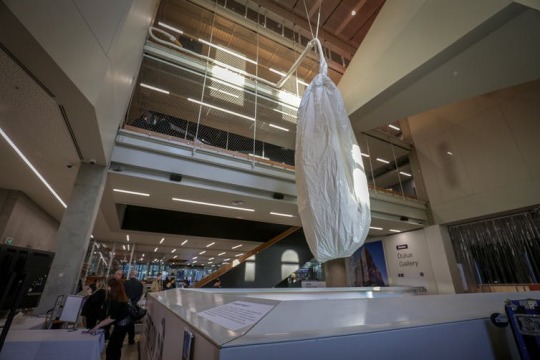
Ant Hamlyn, The Boost Project, 2015. Nicole Cleary
Ant Hamlyn’s The Boost Project and Tyler Payne’s Womanhours both address the pressures of social media.
Hamlyn’s six-metre-tall inflatable is a proxy for the body and the ego. Suspended from the ceiling, this giant orb gives form to the flux and fragility of an online presence. Each time it is liked via its hashtag, The Boost Project gets a 30-second burst of air. On a good day it has a substantial presence at the entrance of the gallery, but when it is ignored the orb slowly deflates, its firmness diminishes, and the suspended form takes on a droopy and dejected demeanour.
Payne’s Womanhours demonstrates the oppression of Instagram. In a series of videos, the artist employs her own body to reveal the level of self-correction needed to achieve the perfect self-portrait. She appears to endure an extreme physical and psychological makeover through female cosmetic rituals such as waxing, tanning, bleaching, plucking and shaving. The perfected self is captured for a fleeting moment in the virtual realm and the ritual is repeated all over again.

Orlan, Omniprésence, 1993. Image courtesy of the artist
Self-correction is also the subject of ORLAN’s performance practice and her body is the canvas for experimentation. No need to repeat these rituals; the interventions are permanent. For decades, ORLAN has undergone plastic surgery in order to shape her face to reflect a version of beauty expressed in the Renaissance paintings. Her new brow resembles the Mona Lisa and her chin belongs to Botticelli’s Venus.
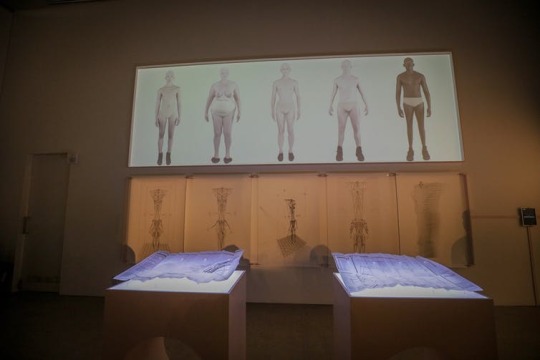
Adam Peacock, Genetics Gym, 2017, video still. Nicole Cleary
In Genetics Gym, Adam Peacock speculates on how genetic technologies could allow us to design our bodies and cognitive dispositions, ramping up the prospects of self-improvement beyond internal and external modification.
Similarly, in Demiurge, Jaden Hastings has accessed her entire gene sequence and used artificial intelligence to analyse potential risks and provide information about what needs to be fixed to achieve a perfect state. In doing so, the artist inserts the machine into the process of human evolution.
Most artists in this exhibition speculate on self-improvement with respect to health, function and beauty, but we might also be driven to modify ourselves through fear. What if the desire to survive a cataclysmic event was the catalyst for reshaping the human form?
Patricia Piccini’s Graham has the perfect body to walk away unscathed from a car crash. Created in collaboration with trauma surgeon Christian Kenfield and the Monash University Accident Research Centre, Graham’s honed and sculpted anatomy will withstand the impact of a 30kph collision. Paradoxically, the unintended consequences of Graham’s modified feet and ankles would appear to make walking very difficult.
Few of us would choose to look like Graham, but he is a metaphor for the lengths we will go to be safe. How far might we go to protect ourselves or our children from threats like terrorism or global warming?
The prospect of hacking, modifying and transforming our bodies presents an unexpected conundrum. Scientific and technological advances inevitably open up an unfettered realm of personal choice when innovations hit the marketplace. But in The Paradox of Choice, economist Barry Schwartz shows that having too many options generates anxiety. It’s hard enough to choose a toothbrush today, let alone make an informed decision about the potential range of future body modifications.
Perfection raises questions about what constitutes a utopian or dystopian future, ethical or unethical practices, a perfect or an imperfect human. The exhibition provides no easy answers but invites us to shift our perception and engage with the world as it is now, and as it might one day become. Be careful what you wish for.
Perfection is showing at Science Gallery Melbourne until November 11 2018.

About The Author:
Julie Shiels is a Lecturer in the School of Art at RMIT University.
This article is republished from The Conversation under a Creative Commons license.
4 notes
·
View notes
Text
Exploring Design Styles: Fractal Art
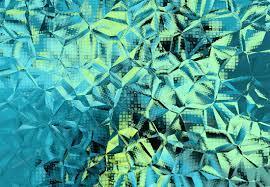
Fractal art sits at the intersection of design and mathematical calculation, which makes it completely mind-bending. this sort of algorithmic artwork results from fractal objects (never-ending patterns that are eternally complex and appear almost like the entire image) represented as various visual artforms, like animation and still images. consider this as mathematical beauty in visualization.
Part of the broader genre of latest media art, fractal art may be a trend that took shape within the mid-1980s. During that point , computer aesthetics also began to develop as an kind , as design became more digitized on the road to the 21st century.
Due to the mathematical complexity of those fractals, algorithmic art that comes with these patterns and shapes is usually mesmerizing and, some would say, hypnotic. One thing’s for sure: It’s an aesthetic that you’ll be easily ready to identify and won’t soon forget.
Prepare to urge your mind blown with this immersive walkthrough on digitized art.
The History of Fractal Art
To figure out where this trend came from, we've to travel back before the 1980s. This decade was known for very retro styles and typography, but, thanks to the then-nascent emergence of computers and therefore the Internet, also for technological inroads in design.
However, as a subset of algorithmic art, the roots of fractal design began with the American computer artist Roman Verostko. His claim to fame is that the invention of his proprietary software for creating original art, back within the 1960s. Verostko’s software manipulates the drawing arm of a pen plotter—a machine initially meant for engineering and architectural illustrations. Verostko’s software changed this application to function as an extension of the artist’s drawing hand and arm.
It’s important to notice that this was more along the lines of computer-generated art and style , as against fractal art proper, since the pc program was written to inform the pen plotter what to try to to (instead of the artworks being created inside computer memory). Still, this is often a distinction without a difference because all art created by fractals is predicated on software created by man (ie, the artist), after all.
To gain a far better understanding of this idea , have a glance at some fractal shapes that are created by designers:

Between the 1960s and mid-1980s, something very profound happened that gave this design trend its identity and name. This was the coining of the word “fractals” by Mandelbrot , a French-American mathematician, in 1975.
In reality, though, the concept of fractals has been around since the 17th century, when the German mathematician Gottfried Leibniz mused about self-similarity (possessing an equivalent , statistical similarity at different scales), a key principle in fractals. By the 19th century, another German mathematician, Karl Weierstrass, came up with the primary definition of a fractal (a function with a graph) while presenting to the Royal Prussian Academy of Sciences.
Still, we can’t ignore Mandelbrot’s contributions to the particular development of fractal art, which is usually created with fractal-generating software. His work led to many , key evolutions that might popularize fractal design within the 1980s:
In 1979, Mandelbrot and IBM programmers came up with the primary fractal printouts.
In 1980, special effects researcher and developer Loren Carpenter presents Vol Libre at SIGGRAPH (Special interest on special effects and Interactive Techniques), a two-minute, computer-generated movie that included fractally rendered landscapes.
In 1983, Acorn User magazine featured a BBC BASIC listing for creating fractal shapes.
Starting in 1984, computer games began to render fractal forms in games like Rescue on Fractalus!
Throughout the 1990s and into the 21st century, fractal art has intensified in popularity, because of the increasing use of software programs, also as designers and artists who are willing to experiment with this visualization of mathematical beauty derived from precision algorithms.
The Diversity of Fractal Imagery
The cool thing about this design trend is that the sheer number of various approaches to the present visualization. In essence, a special mathematical calculation results in a singular visualization of a shape. Here’s a fast rundown of all the ways in which algorithms and even artists and painters can express this style.
Standard Geometry Fractals
This type is predicated on standard geometry.

It relies on iterative transformations found on a starting figure, like a line (the Koch snowflake), a cube (the Menger sponge), or a triangle (the Sierpinski Triangle).
Strange Attractors
This is a gaggle of numerical values to which a mathematical system tends to evolve.
It must even have a fractal structure.
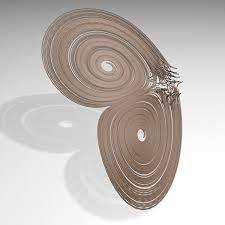
Iterated Function Systems
Iterated function systems are ways to make fractals.

They’re commonly two-dimensional creations and self-similar.
Newton Fractals
These sorts of fractal art created by applying Newton’s method within the plane of complex numbers.

They are boundary sets.
Fractal Flames
Created by Scott Draves, an American video artist and mathematician, in 1992, fractal flames are a part of the iterated function systems class of fractals.

However, they’re unique in their title because their color is predicated on structure rather than density or monochrome.
Mandelbulbs
Mandelbulbs are three-dimensional figures that were created in 2009 by Paul Nylander and Daniel White.
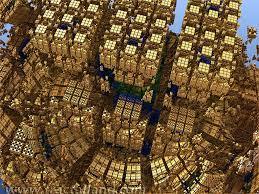
They were created with spherical coordinates.
L-System or Lindenmayer Fractals
Initially, a parallel rewriting system, the L-system or Lindenmayer system are often wont to generate self-similar shapes.

They’re also helpful in modeling the morphology of various organisms.
Fractal Landscapes
As the name implies, these are surfaces generated via algorithms meant to make fractals that replicate the design of natural terrain.
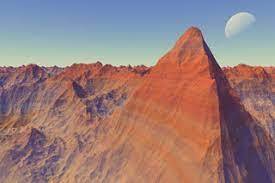
They are created by random fractal processes.
The final sort of fractal art are some things called fractal expressionism. this is often even more special than the shapes we’ve discussed up to the present point because these fractals are created completely by the artists themselves, as against mathematical calculations or computer generations.
For this sort , we've the American painter Pollock to thank. His famous painting style—which involved poured paintings and therefore the quite random wildness typified in other design trends like action painting—has been called both organic and natural by critics.
Fractal expressionism implies that artworks exhibit a straightaway representation of nature’s pattern in their creations.
For some more inspiration, inspect these fractal illustrations created by designers for designers:

The Design Characteristics of Fractal Art
By now, you’ve had an honest , in-depth check out the intricate, mind-bending formations of this digitized sort of art. Here are the common bonds which will always be present in any design that comes with this style:
Self-Similarity – A mathematical concept where an object will always be precisely or simply about almost like any a part of itself. In visual artwork, this suggests that a smaller a part of the entire design will look very almost like the whole and the other way around .
Psychedelia – this is often a regard to altered consciousness and styles that plan to recreate this psychological state , like surreal elements and distortions.
Intricate Patterns – A characteristic tied into the aforementioned self-similarity, this intricacy is seen within the sheer level of detail and complexity of any fractal pattern, given the magnitude of repetition of the shapes.
Mathematical Beauty – The premise on which all fractal art is predicated , mathematical beauty refers to the aesthetic enjoyment viewers get from the abstract, pure, and straightforward organization of math.
Patterns in Nature – Fractals are naturally found in nature in many formations, like clouds, shells, mountains, trees, coastlines, and snowflakes, to call just a couple of . Ergo, when admiring algorithmic art, you’re seeing the wildlife represented during a digitized form.
Vivid Colors – Perhaps the foremost striking feature of those shapes is that the color with which they’re displayed. Whether in manmade fractals (ie, Pollock paintings), natural patterns within the environment, or in digitized software, splendid colors are always an indicator of this design trend.
Now that you simply can identify this style wherever you notice it, let’s mention the interesting techniques at work behind the scenes when you’re beholding these awesome formations.
The Techniques Behind Fractals
For starters, the bulk of this artwork comes from algorithms and computer-generated software, with the brilliant colors mentioned above being intentionally added for pure, aesthetic effect. within the overwhelming majority of cases, it’s never drawn or painted by hand, though a number of the notable artworks from Pollock are the exception.
Fractal-creating software is usually the start line for this fractal art, following this sequence:
Establishing the parameters for relevant fractal software
Calculating the doubtless time-consuming algorithm
Assessing the result
In the post-processing phase, additional software could also be utilized to further change the pictures , and there may even be some non-fractal shapes thrown into the combination , supported the artist’s decision.
These days, everywhere you look, you’ll see fractals because the basis for various sorts of animation and digital art. They’ve also found application in various fields like:
Plant-growth simulation
Landscape generation
Texture generation
If you’d wish to try your hand at creating your own fractal masterpieces, there are various programs, both free and paid, that you simply can use:
Apophysis – For Microsoft Windows systems, this is often an open-source IFS program.
Chaotica – this is often a billboard IFS program specifically for Windows, Mac OS, and Linux. it's free for non-commercial use.
Electric Sheep – this is often open-source, distributed screensaver software that allows you to animate and evolve fractal flames, for display as screensavers on networked computers.
Terragen – A generator for fractal terrains, Terragen produces animations for both Mac OS X and Windows.
Ultra Fractal – Ultra Fractal is an app for generating and rendering fractals. First available in 1999, it’s since become one among the more popular pieces of software for experimenting with these digitized shapes.
Wolfram Mathematica – this contemporary technical computer system empowers you to make fractals.
Examples of Fractal Art
These mesmerizing patterns and shapes abound all around us, whether in nature, created by algorithms, or as tangible structures created by man. Here are some very noteworthy creations.
Manmade Structures
Main Dome of the Selimiye Mosque
In Edirne, Turkey, sits the Selimiye Mosque, which is on the UNESCO World Heritage Site list. If you visit it and inspect the inside of the mosque’s main dome, you’ll see stunning Islamic geometric patterns, which are very similar in design to the repeating sequences of fractals.

The more you check out the intricate forms and shapes, you start to understand that they share the self-similar trait so characteristic of geometry .
Hindu Temples
Another famous, manmade creation that bears a striking resemblance to the present mathematical artwork is that the Hindu temple. thanks to their penchant for repeating patterns and shapes across the whole , gigantic structure, these temples contain tons of styles which will be considered self-similar, which is that the calling card of fractal illustration and style.
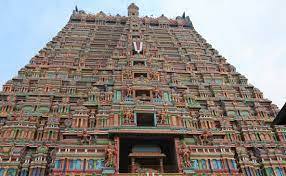
Since the smaller parts of those temples resemble the entire structure, or maybe fit numerous times inside the whole whole, they're said to be fractal in nature.
Algorithmic Fractal Art
This is the “true” and more well-known application of this style once we speak of this trend. the merchandise of algorithms, computers, and programs, this approach to digital art is actually breathtaking and almost limitless in its creativity. Here are a number of the foremost memorable creations we could find.
3D Fractal Ball
Looking sort of a veritable cover from a Tool album, this digital artwork was created in Apophysis, the renderer and editor of fractal flames that’s available on both Mac and Windows,

If you look closely, you'll see that each one of the tiles that are on the black ground are almost like the whole presentation. Even the series of spheres within the center of the composition displays properties of fractal art, thereby making this creation extremely self-similar.
Random Fractal
Created with the Chaotica program for Mac OS X, Linux, and Windows, this random fractal shows what an artist can do with software that has the selective randomization of form parameters.

In essence, it lets the artist hand over a particular degree of control within the creation process. Note how this fractal is a smaller amount symmetrical or balanced that a number of the opposite fractal-based illustrations that we’ve shown you thus far . In spite of this, you'll still appreciate how the varied lines, forms, and patterns relate to every other and to the whole composition as an entire .
Electric Sheep Fractal
Here’s a picture of 1 of the various created through the electrical Sheep project. It shows a figure that’s self-similar, supported the interrogation point squiggles within the foreground being an equivalent shape because the same squiggles farther off within the background.

In addition, the larger, overall image is formed from many, smaller squiggles that appear to travel on forever.
Multi-Layered Fractal
Depending on the mathematical calculations used, a fractal could also be more or less complex. during this case, a multi-layered fractal is one that exhibits extra depth and complexity for the viewer to behold.

Made with the Ultra Fractal software app, this instance of fractal art showcases the immensely gorgeous colors that are possible with this approach to art. Amid the swirling yellows, pinks, reds, and purples, you furthermore may get to ascertain the intricate patterns and spiral shapes seem to stretch on limitlessly. In fact, the left side of the composition displays more complexity than does the proper side of the frame, which is dominated by more regular forms.
Sterling Fractal
Created within the Sterling computer virus , this specific fractal may be a great example of what artists can do with vivid, mind-blowing colors. Featuring mainly cooler colors, this shape calms during a very serene fashion.

From the standpoint of geometry, the composition is additionally a treat, because it features a plethora of curves, swirls, vanishing points, and other aesthetically pleasing forms.
Patterns in Nature
The cool thing is about this sort of art is that you simply can see it in nature, too, without the interference of man. In other words, nature has been creating these wondrous fractals since the start of time—well before our digitized culture started creating fractal art from the mid-1980s onward.
Here are a number of the foremost staggering shapes that nature has got to offer.
Nautilus Shell
Not only does the nautilus shell boast an intricate and interesting pattern, but it also demonstrates a logarithmic growth spiral. Put differently , the self-similarity that’s a key think about fractal art is clear within the development of the shell itself.
Note how the littlest shapes at the very center of the shell bear a striking resemblance to the growing and bigger patterns toward the surface of the shell.
Namib Desert Sand Dunes
The self-similarity of this design trend doesn’t just need to be present in natural objects that are self-contained. they will even be present within the environment, where outside forces act on the landscape itself. Case in point: the sand dunes of the Namib Desert of southern Africa.
The sand patterns are ever-changing because they form supported how the wind blows. However, both the ripples on the surface of the sand and therefore the crescent-shaped dunes themselves reform whenever there are appropriate conditions (read: when the wind blows effectively enough).
A Design Found in Algorithm Art and Nature
Though this digitized art first appeared within the mid-1980s, you'll convincingly argue that it’s been around forever thanks to its uncanny presence in nature. Indeed, perhaps in no other design trend is that the nexus between computerized influence and natural inclination so strong as during this one, learn graphic designing from the high instructions which is providing the best graphic designing course in Delhi
Whether digital or straight from nature, one thing’s clear: The self-similarity concept of this approach to art is mind-bending and wondrous. It’s also the idea of this fractal art, which ensures these timeless, unique designs will still inspire awe in viewers round the globe.
1 note
·
View note
Photo
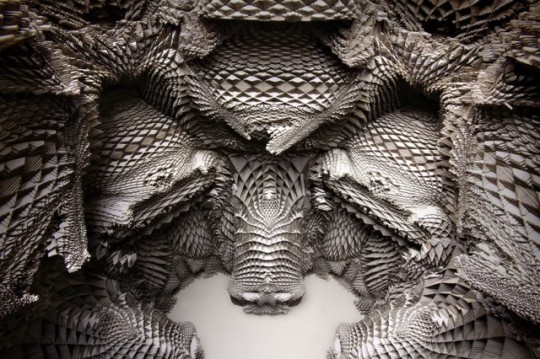
What does this look like to you? First impressions for me were a rendering of a dragon or some abstract fractal in grayscale. This is just a tiny fraction of one side of Michael Hansmeyer’s absolutely amazing columns. 4 years ago I researched Hansmeyer for a calculus project, but I think X-Lab has given his work a new perspective for me. Each of his pillars are laser cut sheets of paper consisting of millions of layers to create full scale stunning surreal columns.

The intricacies within these columns are made in incredibly small slices, and are procedurally generated by a script written by Hansmeyer. What I love about these are it essentially gives the script a base shape, but the code is written in such a way that allows for the pillars to all develop in completely unique and almost organic ways with very organic level details. I don’t know the specific logistics of compiling sixteen million sheets of paper into perfect pillars, but the final project is pretty otherworldly.
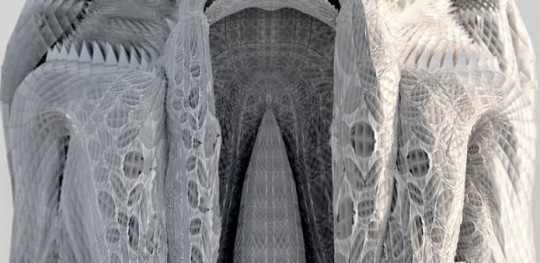
The level of detail that can be achieved by just lines of code is breathtaking.


Each slice by itself consists of a cut path that can exceed 8 meters, and while individual slices more closely resemble snowflake cutouts, it’s hard to believe these are the individual building blocks of such an intricate piece.

What really drew me to rediscover this project was its inventiveness in the world of interdisciplinary work, creating what Hansmeyer calls “Computational Architecture”. A subreddit I found somewhat recently called /r/CreativeCoding really reminds me of this piece, and shows some amazing examples of science and art colliding to make something much more beautiful and detailed than either field could do alone. Hansmeyer’s work to me symbolizes the importance of this kind of cross-pollination. Hansmeyer’s work heavily inspires my final project in a nonlinear way, where I am not striving to be like Hansmeyer, (although this certainly would not be a bad goal) but I am moreso looking to achieve the same level of viewer reaction to my work.

When I see these pillars, they evoke a strong sense of wonder and infinite questioning about the logistics of how in the world such beautiful shapes can occur, and why haven’t I seen this before? I am specifically intrigued by the last question. I think this is something I often wonder about with art in any medium that fascinates me, is I ask why I haven’t seen anything like it before, and how anything could possibly be improved on it. Neither have much of an answer.
In today’s digital world of hyper-exposure to images, I am consistently shocked whenever I see something truly “new”, because I didn’t think new was still possible. Of course new is subjective, but I believe combining modern technology with any art form is a very easy way to get closer to something new. By creating an entire “music video” using a series of poor man’s oscilloscopes, I hope to evoke some of the same curiosity or wonder about my project. This project definitely makes me curious of other examples of math being so closely integrated into detailed architecture. Any suggestions?
6 notes
·
View notes
Text
January 10, 2020

We returned to the North Country School campus this past week after a restful and joyous holiday season, ready to jump back into school programming and embark on new outdoor adventures. In our arts classes, students took part in lessons in our new Teaching and Learning Kitchen and Walter Breeman Performing Arts Center (WallyPAC), while the fresh inches of snowfall around campus provided the perfect playground for outdoor program activities like skiing and sledding. In the upcoming weeks we will begin weekly Whiteface Days on Tuesday afternoons, which provide the entire student body with the opportunity to ski and snowboard at nearby Whiteface Mountain Ski Resort. As winter term continues, we look forward to upcoming auditions for the spring production of Alice in Wonderland, our annual Skimeister competition, Intersession week of special programming, and the 9th grade trip to Utah.
ACADEMICS


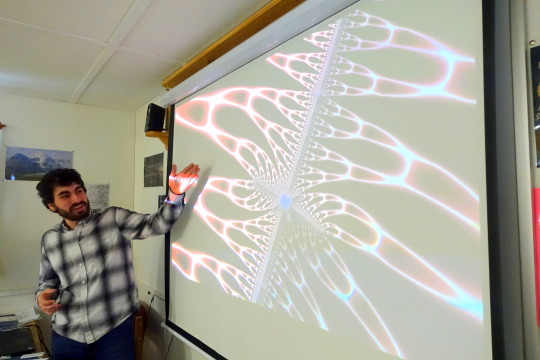

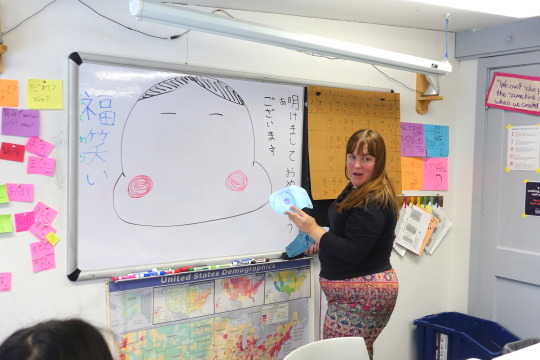
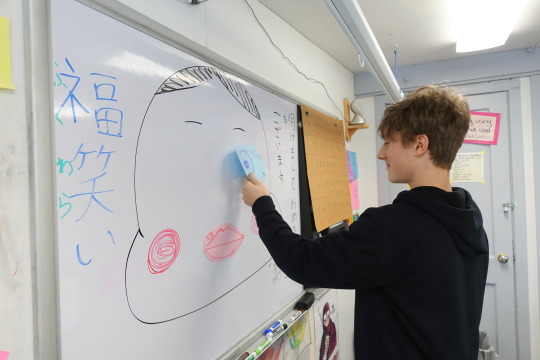


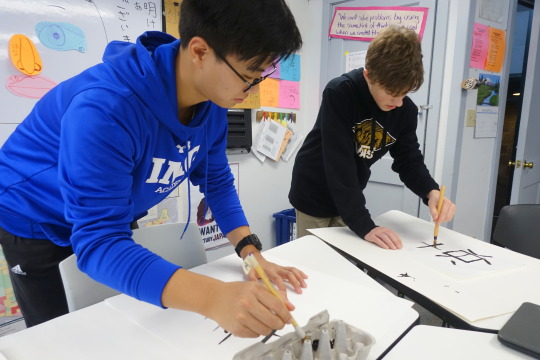


This week our 6th grade math students began studying fractals. Fractals, which are complex shapes that are composed of neverending patterns, appear in nature in the form of tree leaves, shells, vegetables like romanesco, and sunflowers. Fractals can also be created using mathematical formulas. The class, which included students Sweety, Will, and Mia, watched a computer-generated video of a Mandelbrot Set fractal in awe, before taking on a paper-folding assignment that asked the group to predict and then create their own fractal shape.
In Meredith’s Japanese class, students participated in two traditional Japanese New Year’s activities. The first was Fukuwarai, a game where players try to put the pieces of a traditional face in the correct places on the board with their eyes shut. Students learned vocabulary for facial features as well as directions like up, down, left, and right. Kakizome is another traditional New Year’s practice of writing an intention or wish for the coming year using ink and a calligraphy brush. Students chose words to write, learned how to form the characters, and put their best efforts into writing their words and signing their names.
ARTS
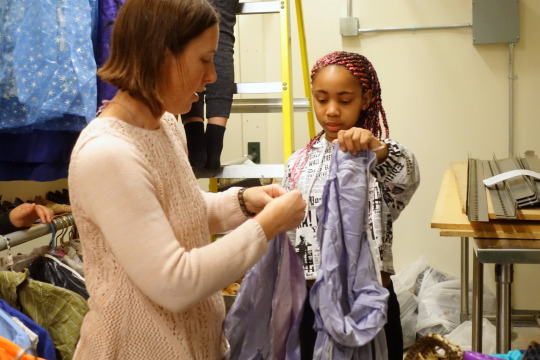
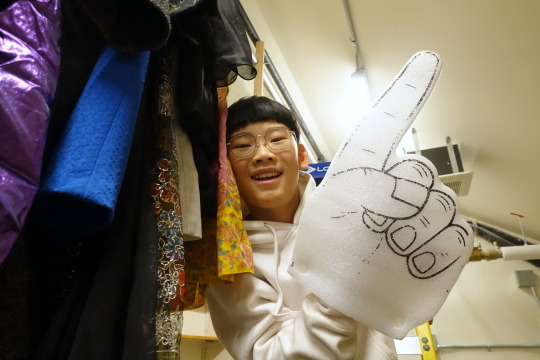
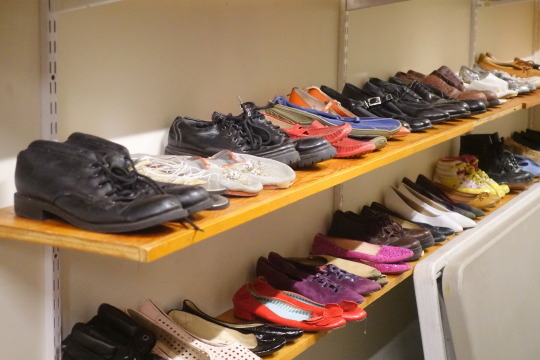
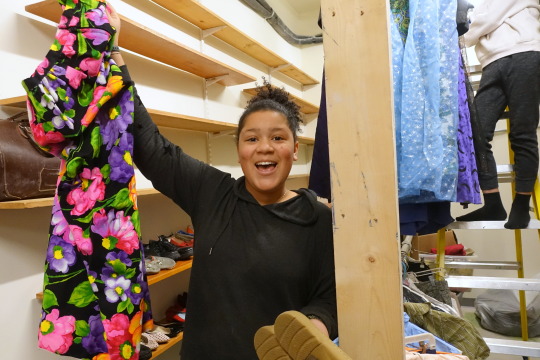


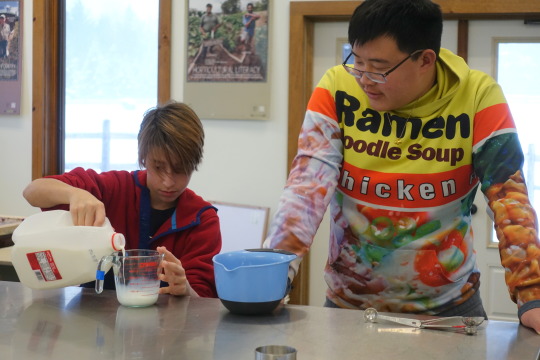


Costuming class moved into the new WallyPAC space this week and began organizing the costume closet for our upcoming production of Seedfolks, which will be performed in collaboration with Northwood High School at the Lake Placid Center for the Arts in mid-February. The class has been designing costumes for Seedfolks since winter term began in early December, and have begun planning out costumes ideas for May’s production of Alice in Wonderland as they sort through the space.
Students in our culinary arts elective, Flour Power, have been exploring grain-based recipes from around the world throughout the winter term. On Wednesday the class took on the challenge of preparing Hokkaido milk bread, also called Japanese milk bread. Students including Ezra, Sam, Sonya, Alex, Tiri, and Grace measured out and prepared ingredients before kneading the bread dough. In Friday’s class the group finished baking their dough and was able to taste their finished product—a light, fluffy, and slightly sweet bread with a soft interior.
OUTDOORS

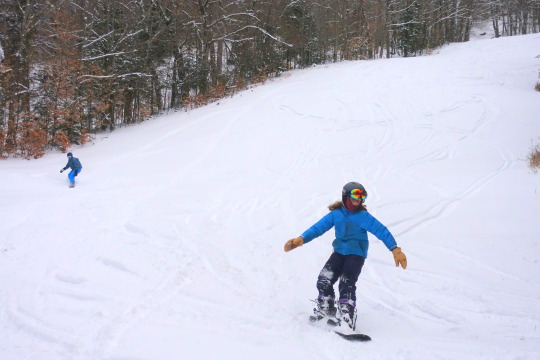


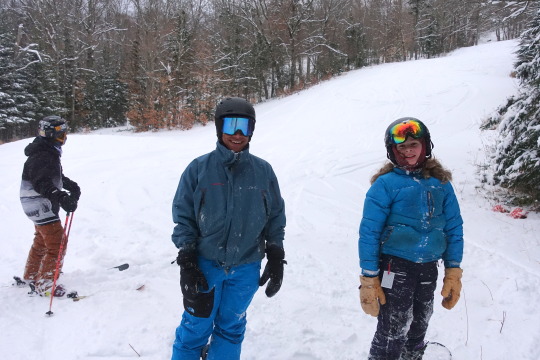

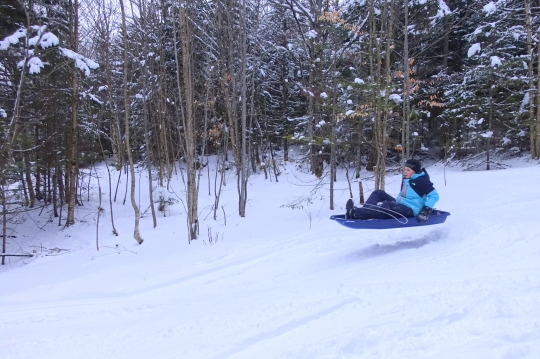
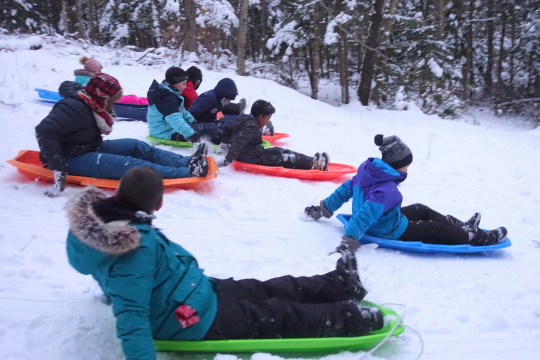
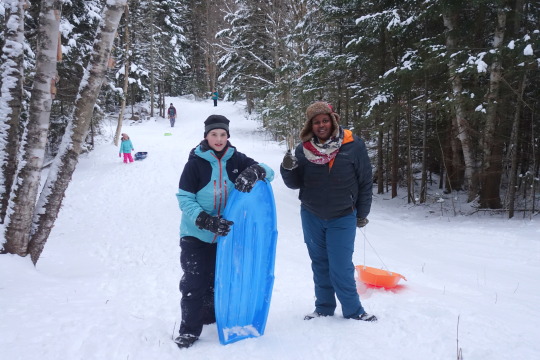
Students returned to our snowy mountain campus this week ready to break out the skis, sleds, and snowboards for a fun array of winter activities. While our Whiteface ski afternoons will begin in a couple of weeks, this week the community enjoyed our own ski hill during out-times and Wednesday’s homenight activities.
Plenty of time was also spent on our sledding hill, where students including Kalina, Tristan, and Steven took solo runs down the hill and participated in an all-group race to the bottom. Colton got some air time on one of the hill’s small jumps, and everyone was able to take in views of our own ski hill and Cascade Mountain in the distance.
FARM AND GARDEN



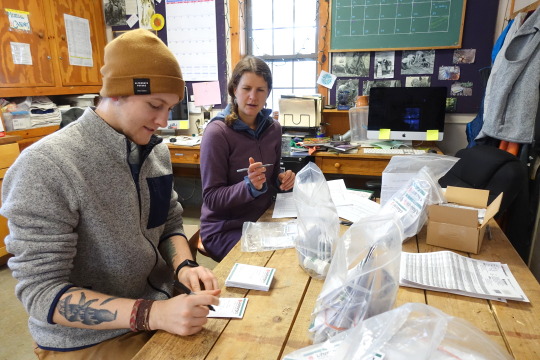



While students and teachers have been on vacation for the past several weeks, the barn staff has been hard at work making sure our farm animals have been well-cared for. Students returned this week ready to pitch in some hands to our hard working farmers during twice-daily barn chores and farm out-times. Farm intern Nick led a student out-time to muck out animal spaces, and students including Azalech and Tianyu helped groom horses during evening barn chores.
Running a working farm means constantly preparing ahead for future seasons, and Garden Manager Tess has been planning for spring seeding since early in the fall term. This week, Tess and Nick began sorting through the new shipment of seeds, as well as organizing the planting schedule for the upcoming planting season. North Country School and Camp Treetops grows over 300 varieties of vegetables, flowers, and herbs that are used in our dining rooms throughout the year. Our seeds are sourced from a handful of small seed companies and co-ops, as well as saved seeds from our own crops. We will begin seeding in our greenhouses in March, and our students will take part in the seeding, transplanting, and early harvesting process throughout the spring term.
Check back next week to see what we’re up to on our mountain campus.
For more information about the #This Week At NCS blog, contact Becca Miller at [email protected].
For general school information, call 518-523-9329 or visit our website: www.northcountryschool.org
0 notes
Photo

Forsythia fractal by John Greene
#generative art#pattern#computer art#programming#creative coding#fractal#math art#colorful#geometry#computers
5 notes
·
View notes